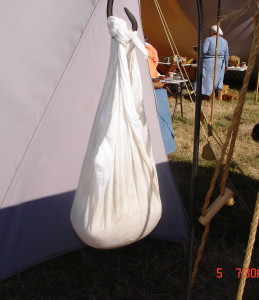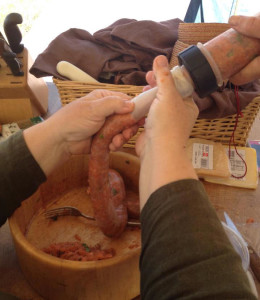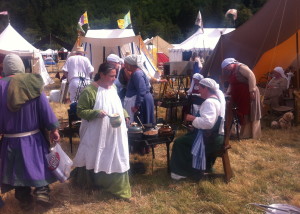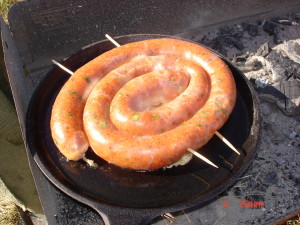It was a medieval cook’s dream vacation! Four full days at West/AnTir War, meeting and playing with other cooks, and making new friends from three different kingdoms. I learned so much – and ate so much – that I was certain either my head or my stomach would explode!
What did I learn? About six new ways to start a fire, the power of flat skewers and the glory of Bread on a Stick. I learned that I can’t have too many new friends and was reminded how lovely it is to reconnect with the old ones. Most importantly, somewhere in the darkest of night in the Redwood Forest, off the road with a flat tire on the trailer and no access to the jack and no air for the spare, without cell service and hope of assistance, there are truly amazing people in this world (who delayed their own trip for two hours to help us), and our inconvenience was worth the price of the opportunity to meet them.
What did I eat? Other than the dozen dishes we made to share, each evening brought one or more offerings from the thirty or so participants in the Play Date. I could not possibly have tasted them all, but (please don’t tell my vegetarian children) I did manage to taste pig testicles, chicken liver fritters, chicken balls, oat groats, craw-fish pie, leeks with bacon, gingered orange peel and cheesy goo. I passed on the quail, duck, partridge and pigeon — I was too full for the stewed bear — but I did manage a bite of frog pie (but not the legs). I loved the clam & almond milk pottage, fire roasted oysters (they melted in my mouth) and fried oysters, scallops, salmon, trout, ling-cod, tuna & halibut (but my own salmon sausage was my FAVORITE). The biggest surprise was how absolutely yummy the dessert peas were, and both pear pies were equally delicious, as was the pine nut candy. I cooked the pig trotters, used the jelly in pork pies, but no one ate the trotters. The clams were delightful, as were the pork rillettes; all the chicken dishes were, as expected, delicious, but I was partial to our sausage-stuffed chicken thighs wrapped in bacon. Goat had nice flavor, but I don’t like to eat off the bones and I tasted Ivar’s garlic-stuffed lamb which was the best lamb I’ve tried (I usually cannot eat it). The sausages were all great — what’s not to like? — and I even managed a taste of the beef tongue pie (it may be true that I will eat *anything* if it is in a pie).
AND the Pacific Northwest is possibly one of the most beautiful places on earth.
<><><>
Each morning, the cooks set about the days’ tasks without much delay. Everyone had brought more than enough food to play with and period recipe sources to peruse. My husband and I were no different. We planned to make twelve dishes, and managed to complete eleven of them — with rather good results, I think.
Dishes we made:
-
- pork sausage & sauerkraut
- stuffed chicken thighs with leek sauce
- fresh bread
- fresh cheese
- pork pies in a standing crust
- salmon sausage
- roast pork loin
- bratwurst
- Genovese tart
- pear pie
- Scottish white pudding
<><><>
Notes on each dish:
pork and sauerkraut: My husband and I have made this many times. We work together as a team, so well, in so many other areas of our lives, and cooking is no exception. He first made this sausage years and years ago, as part of a redaction project we did with The Upper Crust:
In order to make the sausage, take good raw meats of pig, with neither too much nor too little fat, chop very small with a knife, and stir in good spices throughout. Then, stuff very clean intestines of the pig, and expose them to smoke. Tie some of them at the distance of a finger. Others, tie at a different distance. Then they can be cooked or water or on the quick burning coals or in frying pan or however else you want.
 This was my husband’s first experience with making sausage, and he hasn’t ever stopped! Such a simple recipe, yet it taught him so much!
This was my husband’s first experience with making sausage, and he hasn’t ever stopped! Such a simple recipe, yet it taught him so much!
Sausage making is really rather simple, yet so few do it right. I think too many get caught up in the complexities found in modern recipes. “… neither too much nor too little fat” — that’s the secret, really! Sausages were too dry? Add more fat the next time! And we medieval cooks have seen the term “good spices” many times before. In France, every medieval noble household had a favorite spice blend — poudre forte or poudre douce (‘strong powder’ or ‘sweet powder’) — and we have ours, too (which is a blend of ginger, grains of paradise, cinnamon, cloves, cubeb, mace and black pepper).
The sausages were cooked with my homemade sauerkraut, a few apples, a bit of white wine, some thyme, caraway and a bay leaf.
stuffed chicken thighs with leek sauce: This dish was adapted from a recipe first described in Le Viandier de Taillevent, which suggested a chicken carcass be set aside, and the chicken skin be stuffed with a mixture of the chicken meat, ground pork, bacon, pinenuts, Brie, currants and spices. A redaction of this recipe in Early French Cookery suggests a boned chicken be stuffed with the same ingredients. We decided to stuff chicken thighs, instead, and wrap the stuffed thighs with the bacon, rather than including bacon in the stuffing. Served with Almond Leek Sauce from Le Menagier de Paris, delicious!
 We deboned the thighs, flattened them slightly, and stuffed them with a mixture of ground pork, Brie, a couple eggs, pinenuts, a handful of currants, ginger, cinnamon, cloves, salt & pepper. They were wrapped in bacon and then trussed for the spit. Putting them on the spit was only satisfactory, as it was difficult to ensure even cooking. My husband, the perfectionist, very soon took them down from the spit, browned them in a skillet and finished them off in a Dutch oven. No fuss — a simple solution!
We deboned the thighs, flattened them slightly, and stuffed them with a mixture of ground pork, Brie, a couple eggs, pinenuts, a handful of currants, ginger, cinnamon, cloves, salt & pepper. They were wrapped in bacon and then trussed for the spit. Putting them on the spit was only satisfactory, as it was difficult to ensure even cooking. My husband, the perfectionist, very soon took them down from the spit, browned them in a skillet and finished them off in a Dutch oven. No fuss — a simple solution!
 fresh bread and cheese: We bake bread often in our encampment. I make up a very basic dough — most often a combination of whole wheat and unbleached flours, yeast, salt, water, and a touch of honey to make sure my yeast is alive. I lightly knead the dough and set it aside until the next morning — allowing a slow, gentle rise. I have baked this bread many ways, in mud ovens (even in the rain) at Estrella War, on firebricks under a cloche, or (especially at times when I may be distracted with many tasks at hand) in my fail-proof Dutch ovens. I chose the latter this time, as I was making cheese for another recipe and thought fresh bread would be needed for any leftover cheese.
fresh bread and cheese: We bake bread often in our encampment. I make up a very basic dough — most often a combination of whole wheat and unbleached flours, yeast, salt, water, and a touch of honey to make sure my yeast is alive. I lightly knead the dough and set it aside until the next morning — allowing a slow, gentle rise. I have baked this bread many ways, in mud ovens (even in the rain) at Estrella War, on firebricks under a cloche, or (especially at times when I may be distracted with many tasks at hand) in my fail-proof Dutch ovens. I chose the latter this time, as I was making cheese for another recipe and thought fresh bread would be needed for any leftover cheese.
pork pies: I am so disappointed that I did not get pictures of my pies! This was my first attempt at standing crust pies, and they turned out so well! I used a simple dough recipe of flour, hot water, butter and lard, which was actually very easy to use. The pies held together nicely and looked good, too. According to my research, the first pork pies in the Melton Mowbray area of England date to the 14th century, were made of uncured pork and mashed anchovies. I filled mine with diced port, some chopped sage, pepper, nutmeg, and some mashed anchovies.
I did cook pig trotters ALL DAY to make the jelly to top my pies, but I don’t think I got the pies cool enough for the jelly to set. The next time I try them, I may use melted butter, instead. No matter — they were delicious, and I will make them many times.
salmon sausage: A field trip was planned to the local fishmonger’s — so I had to have salmon! This was a perfect excuse to try something I’ve wanted to try for a long time: salmon sausage.
 We love the smokiness that uncured bacon adds to pork sausage, so we decided to try a bit of smoked salmon mixed into fresh. We added some fresh herbs and a few spices from the spice basket. They were delicious!
We love the smokiness that uncured bacon adds to pork sausage, so we decided to try a bit of smoked salmon mixed into fresh. We added some fresh herbs and a few spices from the spice basket. They were delicious!
As a plus, I got to try my hand at hand stuffing the sausages. Earlier, we were shown how to stuff them by hand using a funnel. This time, we tried a friend’s new toy – a sausage “gun”. It worked well, and hand stuffing sure cuts down on the cleanup!
roast pork loin: We used a very standard, very tasty recipe from Le Menagier de Paris:
Bourbelier de Sanglier. (loin of pork in boar’s tail sauce)
First put the loin in boiling water, then take it out and stick it all over with cloves, set it to roast, basting it with a sauce made from spices; that is, ginger, cinnamon, clove, grains, long pepper, and nutmeg, moistened with verjuice, wine and vinegar; and baste with this without first boiling it. And when the roast is done, boil together.
This is a good example of my favorite method of cooking meat in camp. We simply rubbed a pork loin with the spices (no need to put meat in boiling water anymore) and roasted it on the spit, basting with a combination of verjuice, wine and water. When the roast was nearly done, we took it down, allowed it to rest a bit, sliced it and returned it to a sauce made of the same ingredients as were used for basting. We finished it off (kept it gently warm) in a Dutch oven until service.
bratwurst: We used the following recipe from Das Kochbuch der Sabina Welserin:
25. If you would make good bratwurst
Take four pounds of pork and four pounds of beef and chop it finely. After that mix it with two pounds of bacon and chop it together and pour approximately one quart of water on it. Also add salt and pepper thereto, however you like to eat it, or if you would like to have some good herbs, you could take some sage and some marjoran, then you have good bratwurst.
We have a new really great recipe! These were wonderfully moist and had a gentle seasoning. We will be making these often.
I regret that this is the time our phones were both dead, and we didn’t get pictures of many of our dishes. I especially regret not getting pictures of my pies, one sweet and one savory, that were so nicely cooling all day. But, here is what I made:
Genovese tart: also from Das Kuchbuch der Sabina Welserin:
30. To make a Genovese tart.
Take eighteen ounces of chard or spinach, three ounces of grated cheese, two and one half ounces of olive oil and the fresh cheese from six ounces of curdled milk. And blanch the herbs and chop them small and stir it all together and make a good covered tart with it.
I blanched some spinach, squeezed it dry and shredded it. I mixed it with the fresh cheese I had made earlier in the day, some Parmesan and a little olive oil, and baked it between two crusts. So simple and so tasty!
A Warden Pie [Gervase Markham, The English Houswife]:
Take the fairest and best Wardens, and pare them, and take out the hard cores on the top, and cut the sharp ends at the bottom flat, Then boyle them in white wine and sugar, untill the sirrup grow thick. then take the Wardens from the sirrup in a cleare dish, and let them cool. Then set them into the coffin, and prick cloves in the tops, with whole sticks of cinnamon, and great store of sugar as for pippins; then cover it, and onely reserve a vent hole. So set it in the oven and bake it. When it is baked, draw it forth, and take the first sirrup in which the Wardens were boyld, and taste it, and if it be not sweet enough, then put in more sugar, and some rosewater, and boyl it againe a little; then pour it in at the vent-hole, and shake the pye well: then take sweet butter, and rosewater melted, and with it annoint the pye — lid all over, and then strow on it stroe of sugar, and so set it into the oven again a little space, and then serve it up; and in this manner you may also bake Quinces.
Warden pears are no longer cultivated, so I chose to use Anjou, instead. I poached them in white wine, sugar, cloves and cinnamon until just tender, them removed the pears to thicken the syrup slightly. I added a bit of rosewater to the syrup, a small amount of butter, and then returned the pears to the syrup to cool. The pear halves were then arranged in the pie shell in a circle, and topped with a second crust before baking.
The pie was quite simple to make and very delicious.
Scottish white pudding:
 “It fell about the Martinmas time
“It fell about the Martinmas time
And a gay time it was then, oh
When our Guidwife had puddings to make
And she boiled them in the pan, oh.
The wind blew cold from east and north
And blew into the floor, oh
Quoth our Guidman to our Guidwife
Get up and bar the door, oh.
Me hand is in me hussyfskap
Guidman, as you may see, oh
And if it be barred this hundred year
It will not be barred by me, oh.”
What fun was this! The Guidwife of Cliar Cu Buidhe, setting her pudding to boil in the pan! I was so excited to try this, and so happy my pudding was tasty! My research tells me that it was actually beginning in the 14th century that pudding cloths became viable substitutes for animal stomachs — great news for this 14th century Guidwife!
I was SO happy to discover a resident of the Cooks’ Camp actually brought suet that he didn’t need, so I was able to proceed with my recipe. Thank you, thank you, Wulfric! To make the pudding, I needed an equal volume of oats, beef suet and diced onion (I used leeks), and some seasoning ( I used plenty of salt & pepper, but will add some additional seasoning next time). The ingredients were tied up in the pudding cloth and set to boil for most of the day. I then hung the bag, and allowed it to cool before serving. I believe that, if I were able to really get the pudding COLD, I could have sliced them, even brown them in a skillet. Definitely worth trying in the future!
<><><>
“S ann nas fheàrr a bhith fìor ceart ‘sa linn.”



